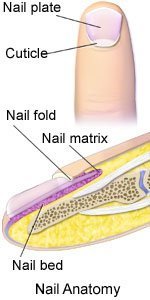- Paronychia, also called perionychia, is an infection and inflammation (redness, pain, and swelling) of your nail fold. The nail fold is the skin around your fingernails and toenails. Paronychia may be acute (sudden) or chronic (happen repeatedly over six weeks or longer). Injury to your nails or nail folds, such as from biting your nails may tear your skin. Germs such as bacteria and fungi may enter through the torn skin, causing an infection. Certain medicines and medical conditions may increase your risk of having paronychia. Skin allergies, certain soaps, chemicals, or repeated water soaking may also increase your risk.

- With paronychia, your nail fold may be painful. Pus may come out of your nail fold when you press against it. With chronic paronychia, your nail may change color or become thick. Your nail may also pull away from your nail fold, and fall off. Your caregiver may ask about your symptoms and do a digital pressure test. You may need medicine to treat your pain, swelling, and infection. You may also need surgery to drain pus or remove your nail and the tissue around it. Treatments for paronychia may decrease redness, pain, and swelling. Treatment may also help prevent the infection from spreading to nearby tissue.
AFTER YOU LEAVE:
Take your medicine as directed:
Call your primary healthcare provider if you think your medicine is not helping or if you have side effects. Tell him if you are allergic to any medicine. Keep a list of the medicines, vitamins, and herbs you take. Include the amounts, and when and why you take them. Bring the list or the pill bottles to follow-up visits. Carry your medicine list with you in case of an emergency.
- Antibiotics: This medicine is given to help treat or prevent an infection caused by bacteria.
- Antifungal medicine: This medicine helps kill fungus that may be causing your infection.
- NSAIDs: Nonsteroidal anti-inflammatory (NSAID) medicine may decrease swelling and pain or fever. This medicine can be bought with or without a doctor’s order. This medicine can cause stomach bleeding or kidney problems in certain people. Always read the medicine label and follow the directions on it before using this medicine.
- Pain medicine: You may need medicine to take away or decrease pain.
- Learn how to take your medicine. Ask what medicine and how much you should take. Be sure you know how, when, and how often to take it.
- Do not wait until the pain is severe before you take your medicine. Tell caregivers if your pain does not decrease.
- Pain medicine can make you dizzy or sleepy. Prevent falls by calling someone when you get out of bed or if you need help.
- Tetanus shot: This is medicine to keep you from getting tetanus. You may be at risk for tetanus if you have skin tears. It is given as a shot. You should have a tetanus shot if you have not had one in the past 5 to 10 years. Your arm can get red, swollen, and sore after getting this shot.
- Topical medicine: This medicine is put on the skin around your nails. This may come as a cream or ointment. Topical medicine may decrease pain and swelling, and may also prevent infection.
Ask for information about where and when to go for follow-up visits:
For continuing care, treatments, or home services, ask for more information.
Caring for myself at home:
- Apply a warm compress on your infected finger or toe to decrease pain and swelling. You may also soak your finger or toe in warm water or a special solution. This solution may contain vinegar or medicine to decrease redness and prevent infection. Ask your caregiver for more information about warm compresses or soaks.
- Keep your infected finger or toe clean and dry at all times.
- Rub lotion into your nail folds, hands, and feet.
- Wear proper footwear to keep your infected toe clean.
Preventing paronychia:
- Rub moisturizing lotion into your hands after washing them.
- Avoid chemicals that may harm your skin and nails. These may include soaps, laundry detergents, cuticle removers, primers, nail hardeners, or nail products containing acetone. Ask your caregiver for more information about other chemicals that may cause paronychia.
- Avoid cutting or removing your nail fold when cleaning your fingernails or toenails.
- Bring your own nail tools when having your fingernails or toenails cared for in nail salons.
- If you have diabetes, keep your blood sugar at the level your caregiver suggests. Your infected nail fold may take longer to heal if you have diabetes. Ask your caregiver for more information about diabetes, and ways to control your blood sugar level.
- Keep your nails short. Do not bite your nails, pick at your hangnails, suck your fingers, or wear fake nails.
- Use cotton-lined rubber gloves or wear two rubber gloves when working with food or water. The gloves will help protect your nail folds.
CONTACT A CAREGIVER IF:
- You have a fever.
- You have pus draining from your infected finger or toe.
- You have questions or concerns about your condition, treatment, or care.
SEEK CARE IMMEDIATELY IF:
- Your swelling and pain worsens in your finger or toe.